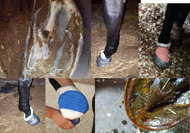As a horse owner Hoof Abscesses are most one of the most irritating causes of lameness. The hours of poulticing, tubbing and general worry that they cause; the ‘is it isn’t it’ or should I call the vet or not is a conundrum we all face.For the poor horse they are massively painful and can develop into some really nasty conditions that can, on the odd occasion, be life-threatening.
WHAT CAUSES HOOF ABSCESSES IN HORSES?
Most abscesses begin with bacteria entering interior hoof structures, usually via the sole-wall junction (just inside
wall and sole can make it easier for bacteria to invade, and some internal hoof injuries (such as bruising) can also result in abscesses.
The most common causes of abscesses include:
- 1.Environmental conditions cycling between wet and dry - In very dry conditions the hoof dries out and can shrink slightly like a dried-out sponge. This can result in tiny hoof cracks and fissures in the sole-wall junction that can then soften and fill with muck when the weather turns wet, allowing opportunistic bacteria to invade the hoof and cause an abscess.
- 2.Penetrating wounds can occur as a result of a horse stepping on a sharp object such as a nail, rock, or broken glass. These injuries may cause a perforation (hole) of the sole that packs up or seals over, and then an abscess results two to four days later as a result of contamination.
- 3.“Close” nails in a recently shod foot (Nail prick or Nail Bind).A horseshoe nail placed too close to or into the foot’s sensitive inner structures can introduce bacteria that cause an abscess. Even if the nail is removed right away and didn’t introduce bacteria, it created a pathway into the hoof that can let in bacteria and result in an abscess later.
- 4.Ground conditions/bruising – Muddy, wet or rocky ground can soften feet and/or cause bruises. Some bruises may abscess if bacteria are introduced through a small external insult or from circulating bacteria in the bloodstream.
- 5.Poor hoof balance/conformationFor example, hoof wall flares can put additional bending stress on the sole-wall junction and cause cracks that can become contaminated. Leaving the bars of the foot too long can also result in localized bruising due to pressure from the ground and therefore potentially abscesses.
- 6.Stable Management – Dirty/Deep Littered stables can be wet and contain lots of bacteria that can invade the foot.
SIGNS OF A HOOF ABSCESS
Similarly to under fingernails there’s little room
for swelling in the hoof. When the pressure from inflammation and pus builds it causes sudden pain and severe lameness. Usually, visible wounds or swelling aren’t present.The onset of lameness can be so sudden the horse may appear to have broken a bone.
The pastern or heel bulbs and coronary band may also be swollen. Often, the hoof wall is warmer, and you can feel pulses near the pastern.Severe abscesses can lead to swelling and infection that goes up the leg to cause Lymphangitis.
Clinical signs (symptoms) depend on the severity of the infection, lameness can vary from mild, minimal lameness progressing to moderate to severe lameness. Other clinical signs might include swelling, heat, draining tracts, increased digital pulse, and evidence of hoof injuries (that can introduce bacteria into inner hoof structures, leading to abscesses).
In severe cases or if the abscess is deep within the hoof, the abscess pocket or its effects, such as deteriorating bone, are visible on an X-ray.
When trimming the hoof, a black spot on the sole or sole-wall junction where a crack or puncture is contaminated with muck can be visible. This stands out in contrast to the rest of the clean, trimmed sole. This contaminated tract can lead to an abscess.

TREATING AN ABSCESS
The goal of treatment is to drain the abscess
and prevent further infection. Due to the level of pain, it’s inhumane to wait for the abscess to rupture on its own.
Finding the source:
The vet or farrier will use hoof testers to pinch parts of the foot and find the source of pain. They may find a crack or drain track after cleaning the hoof and removing the old sole.
In severe cases if the drain track can’t be found the vet may X-ray to
look for gas (produced by bacteria) within the hoof. This will also help rule out other causes of lameness.
Draining the abscess
Once the vet or farrier finds the abscess area, they can use a paring knife to cut a hole just large enough to drain the pus. Some horses will need analgesics (pain relievers) or local nerve blocks. Normally, the horse has sudden pain relief once the infection drains.
Bandaging the abscess
Apply a poultice to keep the abscess draining for 48 hours, we recommend Animlintex as it contains a drawing agent.Adding Epsom Salts to the poultice can be useful. Cover the bandage with a hoof boot. This covering must stay clean to prevent lengthening the infection or dirtying the drain hole and change every 12 to 24 hours depending on the amount of pus that is coming out.
Keep your horse in a clean, dry area, such as a well-bedded stall or small paddock (turnout is preferable as the movement helps to drain the pus).
Remove and change the bandage daily.
Keep the hoof bandaged until the draining stops, the hole is dry and the lameness is gone.

RECOVERY FROM AND PREVENTING ABSCESS
Horses with a mild infection can usually return to work in less than a week. Deep infections can take several weeks to heal
PREVENTING:
Keep your horse’s environment clean and dry. Routinely clean stalls and remove manure from paddocks.
Apply hoof hardeners before extreme weather changes. Hoo
f hardeners protect the hoof wall from too much moisture. You can use pine tar or other covering to hold in moisture during drought.
Routinely trim your horse’s hooves.
Remove any nails, tools, rocks, metal pieces, and glass from your horse’s area to lower the risk of injury.
REPEATED HOOF ABSCESS
Poulticing Essentials for every first aid kit:
- Self adhesive bandages such as Vetrap, Wraptec or Naf Wrap.
- Hoof Boot/Poultice Boot or Gaffer Tape
- A hoof knife (for the more experienced – on speaking to a vet it isn’t just a vet or farrier who can use these)



